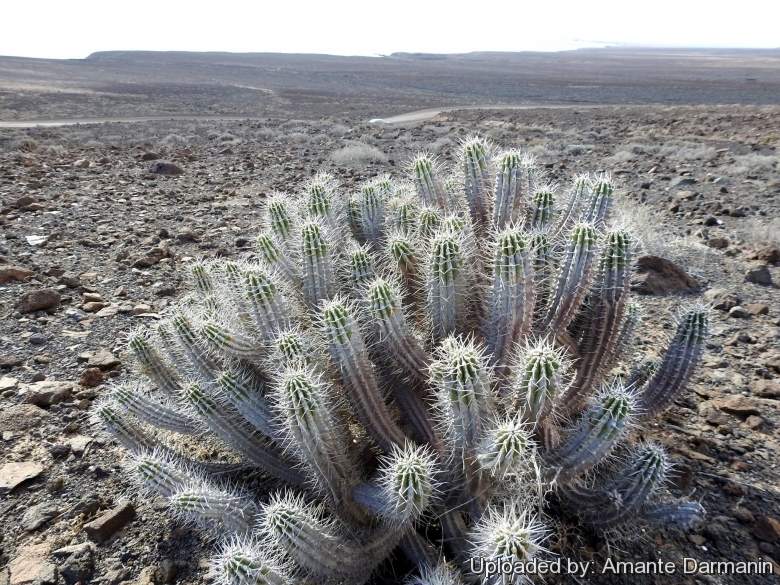
Euphorbia handiensis Photo by: Amante Darmanin
Growing habit at Joros valley, Fuerteventura (Canary), 19 January 2017. This cactus-like Euphorbia grows only in the south of Fuerteventura and is now close to extinction.
Origin and Habitat: It is strictly endemic with only two known locations within the protected area of the "Parque Natural de Jandía", Jandia Peninsula, island of Fuerteventura which is the second largest isle of the Canary Islands archipelago, Spain. Area of occupancy of about 12 km².
Altitude: 50 to 300 m above sea level.
Habitat: It grows in large colluvial volcanic valleys on slopes and watercourses of ravines, in stony soils among basalt rocks. The climate is very dry, windy and hot, and rain is often limited to only one rainfall per year. It is locally very abundant with a total population of more than 200,000 individuals)
Ecology: It grows within xerophitic communities (common succulent species comprises Euphorbion canariensis and Aeonium sp.) and it is pollinated by greenbottle flies.
Synonyms:
See all synonyms of Euphorbia handiensis
back
Accepted name in llifle Database:Euphorbia handiensis BurchardBot. Jahrb. Syst. 48(107): 15 1912Synonymy: 2
back
Common Names include:
ENGLISH: Jandía thistle
SPANISH (Español): Cardón de Jandía
Description: Euphorbia handiensisSN|23775]]SN|23775]] is a small clumping, columnar cactus-like shrub up to 1 m tall with sparse, long white spines, branching near the ground and rebranching forming relatively large specimens with age. Euphorbia handiensisSN|23775]]SN|23775]] which is recognized as one of the rarest euphorbias under cultivation today. The inaccessibility and limited area of its habitat, together the slow growth of seedlings will keep this species always among the rarer euphorbias.
Stem: Columnar, erect, 6-8 cm in diameter, young part of the stem pale or bright green, older ones often greyish.
Ribs: 8-12 non-angular or moderately acute with relatively deep furrows.
Spines: About 3 cm long, paired, spreding and joined at the base, red soon becoming white, spine shield, horny, grey and confluent, forming a hard ridge down the middle of the rib. The species comprises plants with variable spine length, in the same area it is possible to find both plant with short spines (occasionally completely spineless) and plant with long spine (up to 5 cm long), along with intermediate forms.
Flowers: It is a hermaphrodite plant with small amber-yellow to yellowish-green cyathia on very shot peduncles. The cyathia are solitary or in simple cymes and up to 2 mm in diameter. Nectar glands green.
Bibliography: Major references and further lectures
1) Marrero Gómez, M.V. & Carqué Álamo, E. 2011. Euphorbia handiensis. The IUCN Red List of Threatened Species 2011: e.T161847A5503670. http://dx.doi.org/10.2305/IUCN.UK.2011-1.RLTS.T161847A5503670.en. Downloaded on 10 February 2017.
2) Moreno, J.C. (coord.). “Lista Roja 2008 de la Flora Vascular Española.” Dirección General de Medio Natural y Política Forestal (Ministerio de Medio Ambiente, y Medio Rural y Marino, y Sociedad Española de Biología de la Conservación de Plantas), Madrid.. 2008.
3) Marrero Gómez, M.V. and Carqué Alamo, E. Euphorbia handiensis. In: A. Bañares, G. Blanca, J. Güemes, J.C. Moreno and S. Ortiz (eds), “Atlas y Libro Rojo de la Flora Vascular Amenazada de España”, pp. 890. Dirección General de la Conservación de la Naturaleza, Madrid. 2004.
4) Gobierno de Canarias. Consejería de Agricultura, Ganadería, Pesca y Medio Ambiente. 2009. “Fichas de Evaluación de especies amenazadas de Canarias 2009”. 2009
5) Euphorbia: Review of the International Euphoriba Society, V.1, No.1- January 1935-, Volumes 1-3 International Euphorbia Society, 1935
6) Urs Eggli “Illustrated Handbook of Succulent Plants: Dicotyledons” Springer Science & Business Media, 2002
7) Hermann Jacobsen “Abromeitiella to Euphorbia” Blandford Press, 1960
8) Hansen, A. & P. Sunding “Flora of Macaronesia”. Checklist of vascular plants. 4. revised edition. Sommerfeltia 17: [1-295] 1993.
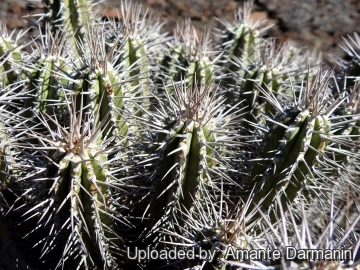 Euphorbia handiensis looks like a spiny cactus. Joros valley, Fuerteventura (Canary), 19 January 2017 Photo by: Amante Darmanin
Euphorbia handiensis looks like a spiny cactus. Joros valley, Fuerteventura (Canary), 19 January 2017 Photo by: Amante Darmanin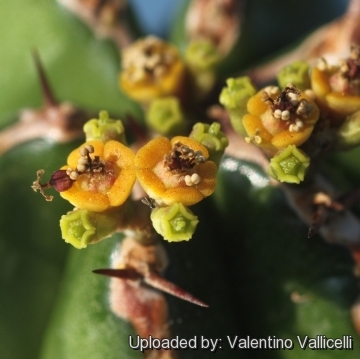 Euphorbia handiensis Photo by: Valentino Vallicelli
Euphorbia handiensis Photo by: Valentino Vallicelli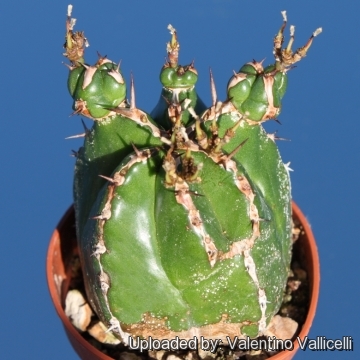 Euphorbia handiensis Photo by: Valentino Vallicelli
Euphorbia handiensis Photo by: Valentino Vallicelli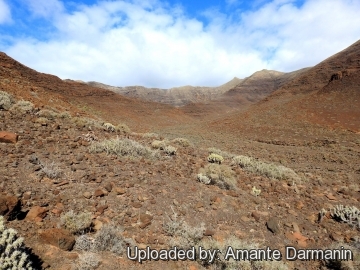 Joros valley, Fuerteventura (Canary), 19 January 2017 Euphorbia handiensis grows near the coast. Photo by: Amante Darmanin
Joros valley, Fuerteventura (Canary), 19 January 2017 Euphorbia handiensis grows near the coast. Photo by: Amante Darmanin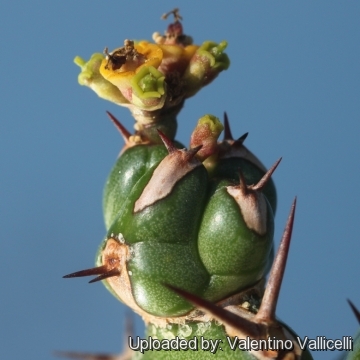 Euphorbia handiensis Photo by: Valentino Vallicelli
Euphorbia handiensis Photo by: Valentino Vallicelli Euphorbia handiensis Photo by: Valentino Vallicelli
Euphorbia handiensis Photo by: Valentino VallicelliCultivation and Propagation: It is an easy species to grow that is suited for any well drained soil in full sun. Give the plant an airy growing medium which mainly consists of non organic material such us clay, pumice, lava grit, and only a little peat or leaf-mould. Water regularly during the active growing season. No water should ever be allowed to stand around the roots. Keep almost completely dry in winter. It is a moderately fast grower, and will quickly become large landscape masterpieces in just 3-5 years. If plant becomes reddish, this is a sign that the roots have not developed properly. It is a relatively fast growing and long lived plant and once established, it will be content in its position and with its soil for years. It can tolerate moderate shade, and a plant that has been growing in shade should be slowly hardened off before placing it in full sun as the plant will be severely scorched if moved too suddenly from shade into sun.
Propagation: The plant can be reproduced by seeds or cuttings.
















